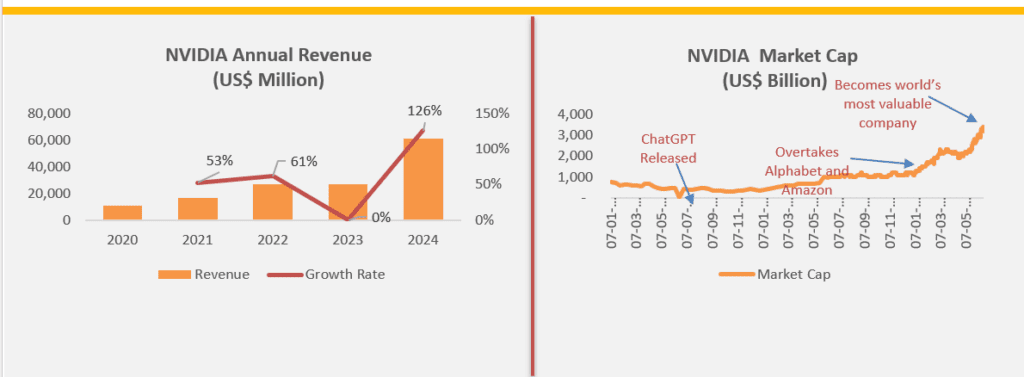Author: Vishesh
Introduction
NVIDIA, the Silicon Valley-based technology company initially known for its cutting-edge Graphics Processing Units (GPUs), has emerged as a key player in the rapidly evolving artificial intelligence (AI) landscape. This transformation has revolutionized NVIDIA’s business and serves as a blueprint for other companies aiming to leverage AI for growth and innovation. This article delves into NVIDIA’s journey from a GPU manufacturer to an AI powerhouse, the innovations and products that have driven their success, and the future developments on the horizon.
NVIDIA’s Journey into AI
The pivotal moment for NVIDIA came in the early 2010s when GPUs’ potential for AI and machine learning became evident. Recognizing this, the company shifted its focus to AI, investing heavily in research and development. As the demand for AI grew, NVIDIA’s GPUs became the preferred hardware for training and deploying advanced algorithms due to their superior performance and energy efficiency over traditional CPUs.
In 2012, NVIDIA’s GPUs powered the breakthrough AlexNet model, which won the ImageNet competition and showcased the power of deep learning, thus positioning the company as a key player in the AI revolution. The introduction of Tensor Core GPUs in 2017 further revolutionized AI workloads, significantly reducing training time.
Beyond hardware innovation, NVIDIA has heavily invested in AI research and development. Collaborations with leading institutions and the development of open-source frameworks like CUDA and cuDNN have fostered a robust AI community, enabling developers worldwide to create innovative AI applications across various industries.
Key Factors Contributing to NVIDIA’s Success in AI
CUDA and GPU Acceleration
NVIDIA’s CUDA platform provided a robust software ecosystem, enabling developers to harness the parallel processing capabilities of GPUs for AI and machine learning applications. This gave NVIDIA a significant advantage over its competitors.
Tesla and Data Center GPUs
NVIDIA’s Tesla GPUs, designed for data centers, have become the backbone of AI infrastructure. These GPUs power high-performance computing (HPC) and AI workloads, offering unparalleled performance and efficiency. Tesla GPUs are used by leading tech companies, research institutions, and cloud service providers to train and deploy AI models at scale.
NVIDIA DGX Systems
The NVIDIA DGX systems, an integrated AI supercomputing platform, have revolutionized AI research and development. These systems give researchers and data scientists the computational power to accelerate AI innovation. The DGX A100, for example, delivers the performance of an entire data center in a single system, making it a critical tool for AI development.
Ecosystem Partnerships
NVIDIA has forged strategic partnerships with leading technology companies, including Amazon, Google, Microsoft, and Meta. These partnerships integrate NVIDIA’s GPUs and AI software into their cloud platforms and services, making the company the standard for AI infrastructure.
Specialized AI Hardware
NVIDIA has continuously pushed the boundaries of GPU technology. The introduction of specialized chips such as the Tensor Core and the Ampere architecture has optimized GPUs for AI workloads, solidifying NVIDIA’s position as the market leader in AI hardware.
NVIDIA AI Software Stack
NVIDIA’s comprehensive AI software stack, including libraries and frameworks such as cuDNN, TensorRT, and the NVIDIA Deep Learning SDK, has simplified the development and deployment of AI applications. These tools optimize the performance of AI models on NVIDIA GPUs, enabling developers to achieve faster results with less computational effort and development time.

Acquisitions and Investments
NVIDIA has strategically acquired companies and made investments to expand its AI capabilities. Notable investments include Ayar Labs for chip-to-chip optical connectivity and Hugging Face, a hub for advanced AI models. They have also invested in enterprise solutions like Databricks, a leading data platform for machine learning, and Cohere, which provides enterprise automation through AI. Additionally, acquisitions like OmniML, an edge optimization platform, and DeepMap, a high-definition mapping company, demonstrate NVIDIA’s commitment to expanding its AI capabilities across various sectors, from edge devices to autonomous vehicles.
Future Developments and Roadmap
NVIDIA’s roadmap for the future is centered around continued innovation in AI and expanding its ecosystem. The key areas of focus include the following:

AI Chip Market Landscape
The AI chip market has experienced substantial growth driven by the increasing adoption of AI and machine learning technologies across various industries. In 2023, the global AI chip market was valued at approximately US$23 billion and is expected to grow at a compound annual growth rate (CAGR) of 31% to reach US$150 billion by 2030.
China is a major player in this market, contributing around 40% of the total market share. NVIDIA dominates the AI chip market in China, holding around 90% of the market, which is valued at approximately US$7 billion. This significant presence underscores China’s importance in the global AI chip landscape.
NVIDIA’s Share in China and Globally
NVIDIA is the leading player in the global AI chip market, commanding an estimated 85% of the market for AI accelerators used in training and deploying models like OpenAI’s GPT. This dominance has propelled the company’s financial success, with its market cap reaching US$3.3 trillion on June 18, 2024, making it the most valuable public company in the world.
Despite its global dominance, NVIDIA faces challenges due to US export restrictions on AI chips to China. These restrictions have created a substantial opportunity cost for NVIDIA, as it cannot fully leverage the growing demand in the Chinese market.
Market Demand and Potential Shortages
The AI chip market is projected to exceed US$100 billion in annual sales within the next five years, driven by the widespread adoption of AI technologies in sectors such as edge AI, autonomous vehicles, and cloud computing. However, potential shortages loom due to a limited number of manufacturers and supply chain disruptions.
NVIDIA’s current inability to meet the surging demand for its H100 GPUs has created opportunities for competitors like AMD and Intel to capture market share. Other players, including startups like Cerebras and SambaNova Systems, are also entering the market, indicating its capacity to support multiple vendors. NVIDIA is addressing demand with plans to release the upgraded H200 GPU around the second quarter of 2024, while AMD prepares to launch its MI400 data center GPU in 2025.
US export restrictions on AI chips to China have created a gap that local firms, such as Huawei Technologies, are starting to fill. NVIDIA plans to comply with the latest restrictions, but ongoing US regulations are prompting Chinese companies to switch to domestic products. Huawei and other Chinese chipmakers like Hygon Information Technology and Moore Threads Technology are emerging as alternatives, although they face challenges with mass production.
Many Chinese chipmakers are subject to US export restrictions and lack their own fabrication plants, limiting their ability to do business with major contract manufacturers like Taiwan Semiconductor Manufacturing Co., Huawei, while advancing with its Ascend chips, struggles with refining mass production, with current yields just over 20%.
Competitive Landscape and Strategies for Staying Ahead
The competitive landscape in the AI chip market is highly dynamic. NVIDIA’s pricing power, flagship AI GPUs, and CUDA software have created a significant competitive advantage. However, competitors like AMD and Intel are capitalizing on the current market dynamics by ramping up their production and expanding their capabilities. Transitioning from training AI models to inference deployment provides an opportunity for other manufacturers to offer alternatives to NVIDIA’s GPUs, especially if they are more cost-effective.

To stay ahead in this competitive landscape, companies should focus on the following:
- Innovation and R&D: Continuously investing in research and development to create advanced AI-specific chip designs and optimize software tools for hardware performance.
- Strategic Partnerships: Building strong alliances with cloud providers, research institutions, and industry groups to accelerate AI development and deployment.
- Diversification: Expanding their customer base and presence in emerging markets to reduce dependence on any single region or market.
- Embrace Open Source: Supporting open-source frameworks can foster a community of developers and accelerate the adoption of AI technologies.
Conclusion
NVIDIA’s journey from a GPU manufacturer to a leader in the AI revolution underscores the company’s vision, innovation, and strategic execution. By investing heavily in AI research, developing specialized AI products, and fostering a robust ecosystem of partners and open-source initiatives, NVIDIA has positioned itself as a central player in shaping the future of AI.
As AI continues to evolve, NVIDIA’s technology and solutions will remain crucial for businesses across various industries. Companies looking to capitalize on the AI revolution can draw inspiration from NVIDIA’s success and adopt similar strategies. By aligning their efforts with NVIDIA’s AI capabilities, businesses can accelerate their AI-driven initiatives, innovate across emerging technologies, and thrive in the rapidly evolving digital landscape.
At Infiniti Research, we specialize in custom market research to help businesses navigate the complexities of the AI landscape. Our services can assist companies in identifying key opportunities, understanding market trends, and developing strategic plans tailored to their unique needs. By leveraging our insights, businesses can make informed decisions, mitigate risks, and maximize their investments in AI technology.
NVIDIA’s journey serves as both a blueprint and an inspiration for success in the AI era. Partner with us to uncover the immense opportunities available and ensure your company remains at the forefront of this transformative technology.


